

Baccarat. Baccarat (IPA: [bakaʁa]; German: Burgambach) is a commune in the Meurthe-et-Moselle department in northeastern France.
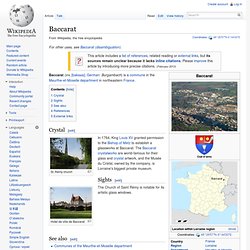
Crystal[edit] St. Remy church Sights[edit] Hotel de ville de Baccarat The Church of Saint Rémy is notable for its artistic glass windows. Royal baccarat scandal. The Royal baccarat scandal, also known as the Tranby Croft scandal, was an English gambling scandal of the late 19th century involving the future King Edward VII.
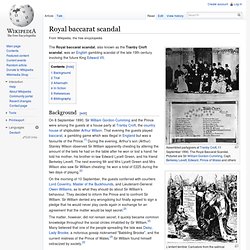
Background[edit] On the morning of 10 September, the guests conferred with courtiers Lord Coventry, Master of the Buckhounds, and Lieutenant-General Owen Williams, as to what they should do about Sir William's behaviour. They decided to inform the Prince and to confront Sir William. Sir William denied any wrongdoing but finally agreed to sign a pledge that he would never play cards again in exchange for an agreement that the matter would be kept secret.[2] Origin of the Baccarat Card Game. Baccarat is card game of Italian origin as most game historians have noted.

Even though the exact origin of this fancy card game is still subject to debate, most researches have traced the origin of baccarat to a middle age game of Tarrochi. This is, by far, the one of the earliest references to baccarat and was played using a deck of tarot cards. In 1490 A.D., during the reign of the French King Charles VIII, baccarat was introduced from Italy. The card game quickly found its way in the homes of the French noble class, and became exclusive among the country's upper aristocratic class. This made baccarat highly-associated with sophistication and elegance that still persists even up to these days.
Theories of the Historic Origin of Baccarat. Baccarat, one of the classy and exciting casino games, enjoyed by many online casino players, does not have clear origins.

There are a few different suggestions and opinions as to where baccarat really originated, but none are conclusive. One such version is that Felix Falguierein originally played the game with a deck of Tarot cards. He was an Italian gambler in the middle ages. There is, however, no proof that this is true. The Origins of Baccarat Card Game: France, America and Others - The Origins of Baccarat Card Game: France, America and Others. Baccarat History : Gambling-Baccarat.com. Baccarat name The Italian word "baccarat" means "zero" in English.

扑克牌. 撲克牌 撲克牌(Anglo-American playing card、French deck),簡稱撲克,直譯為英美牌、法國牌,香港俗稱啤牌,是英國、美國、華人圈等地最常使用的遊戲牌牌具。
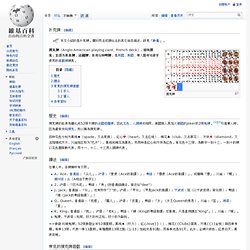
Playing card. A social game using playing cards.
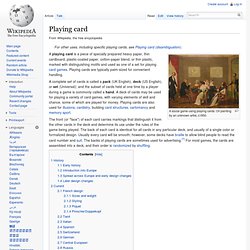
Oil painting by an unknown artist, c1850. A playing card is a piece of specially prepared heavy paper, thin cardboard, plastic-coated paper, cotton-paper blend, or thin plastic, marked with distinguishing motifs and used as one of a set for playing card games. Playing cards are typically palm-sized for convenient handling. History[edit] Early history[edit] A Chinese playing card dated c. 1400 AD, Ming Dynasty, found near Turpan, measuring 9.5 by 3.5 cm. By the 11th century, playing cards were spread throughout the Asian continent.[9]:309 During the Ming Dynasty (1368–1644), characters from novels such as the Water Margin were widely featured on the faces of playing cards.[9]:132 Introduction into Europe[edit] The Mameluke deck contained 52 cards comprising four "suits:" polo sticks, coins, swords, and cups.
Medieval gambling cards, from the year 1377. Spread across Europe and early design changes[edit] No examples of printed cards from before 1423 survive. First cards. Emperor Yizong of Tang. According to traditional historians, Emperor Yizong did not pay much attention to governmental affairs but instead chose to live in opulence, became an alcoholic and surrounded himself with women while his government levied heavy taxes on its citizens.
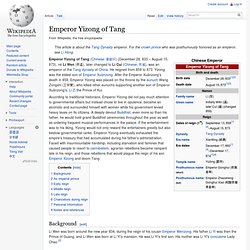
A deeply devout Buddhist, even more so than his father, he would hold grand Buddhist ceremonies throughout the year as well as ordering frequent musical performances in the palace. If the entertainment was to his liking, Yizong would not only reward the entertainers greatly but also bestow governmental ranks. Emperor Yizong eventually exhausted the empire's treasury that had accumulated during his father's administration. Faced with insurmountable hardship, including starvation and famines that caused people to resort to cannibalism, agrarian rebellions became rampant late in his reign, and those rebellions that would plague the reign of his son Emperor Xizong and doom Tang. Tang Dynasty.
History[edit] Establishment[edit] Administration and politics[edit] Initial reforms[edit] Taizong set out to solve internal problems within the government which had constantly plagued past dynasties.
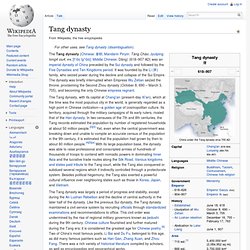
Building upon the Sui legal code, he issued a new legal code that subsequent Chinese dynasties would model theirs upon, as well as neighboring polities in Vietnam, Korea, and Japan. The Tang had three departments (Chinese: 省; pinyin: shěng), which were obliged to draft, review, and implement policies respectively. Tang era gilt-gold bowl with lotus and animal motifs Although the central and local governments kept an enormous number of records about land property in order to assess taxes, it became common practice in the Tang for literate and affluent people to create their own private documents and signed contracts. Spanish cards. Spanish cards in 18th. Italian cards(bowl) in 15th. Gambling cards in 14th centuries. Ancient persia cards.